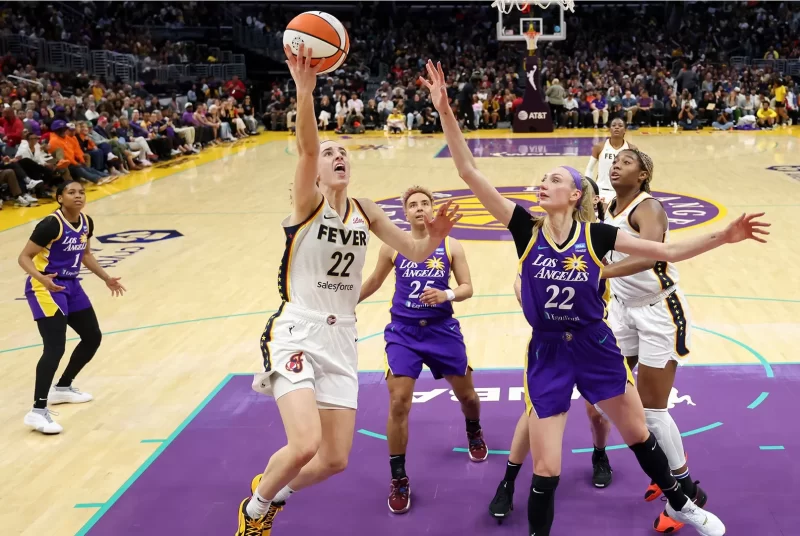Three WNBA Teams to Watch Out for This Season

‘Expansion’ was the word as the WNBA recently began its 29th season. There’s a new team (Golden State Valkyries) with more on the way, and a new schedule (44 WNBA games, an increase of four over last season).
That baker’s dozen gets pared down to eight, making the postseason (seeded by best record, regardless of conference).
Looking for the title, defending (first-ever) champion New York Liberty are 9-4 (+225) to repeat. The Liberty is again figure to be led by Sabrina Ionescu and Breanna Stewart. Meanwhile, Caitlin Clark and the Indiana Fever join three-time MVP A’ja Wilson and the Las Vegas Aces as 13-4 (+325) second choices. Napheesa Collier and the Minnesota Lynx, bridesmaids at Liberty last season, are 4-1 (+400) on the board, per WNBA odds.
Examining some of the props, it’s the Liberty favored to 7-4 (+175) to lead in wins, and a 5-2 (+250) choice to win the Commissioner’s Cup.
The MVP money is on either Clark, Wilson, or Collier, all between 2-1 (+200) and 3-1 (+300).
Here’s a bit of a primer on the WNBA entering the 2025 season…
How Much Is Caitlin Clark Going to Make in the WNBA?
Much of the interest in the WNBA is due to the rise of the Indiana Fever’s Caitlin Clark. Rookie of the Year last season after a record-setting college career at Iowa, Clark ended 2024 averaging 19.2 points, 5.7 rebounds, and 8.4 assists per game. Her 2025 season began with a triple-double (20 points, 10 points, 10 assists) in a win over the Chicago Sky.
While the Fever made the playoffs in 2024, they were bounced in one game. As was mentioned, improvement is expected in the Fever’s WNBA standings this season.
If you’re wondering, Clark’s WNBA salary is approximately $78,000. But she is making $28M from sponsorship deals.
How Long Is a WNBA Season?
The ladies now play a 44-game regular season (increase of four games over last season), with the top eight teams (regardless of conference) making the playoffs. There’s a new-look format to the postseason among WNBA games, as in the first-round best-of-three, semifinals best-of-five, and finals best-of-seven.
What Is the Four-Year Rule for the WNBA?
The WNBA’s four-year rule applies to those players eligible to be drafted. Quite simply, potential draftees have to be four years past high school graduation (or 22 years of age during the year of the draft) to be eligible. There’s an asterisk for being a college graduate of a four-year school within three months of the draft (regardless of age).
This season’s frosh crop has overall first selection Paige Bueckers of the Wings well into minus-money to be voted Rookie of the Year in Dallas. She had a 10-point, seven-rebound, two-assist debut against the Minnesota Lynx in a WNBA game today, losing effort.
Any Final Thoughts?
Those who watch, wager, or both on WNBA scores during WNBA games today live can certainly name the elite teams and players in the league. Odds are suggesting three or four teams are serious contenders to win the title, but let’s see how the elongated regular and postseason unfold before (or if) that fact is true.
Related: Paige Bueckers Is a Lock for WNBA ROY
A Brief History of the WNBA
The Women’s National Basketball Association (WNBA) was founded on April 24, 1996, as a professional basketball league for women in the United States, backed by the NBA. It aimed to capitalize on the growing popularity of women’s basketball, spurred by the success of the 1996 U.S. Olympic team. The league began play on June 21, 1997, with eight teams: Charlotte Sting, Cleveland Rockers, Houston Comets, Los Angeles Sparks, New York Liberty, Phoenix Mercury, Sacramento Monarchs, and Utah Starzz.
In its early years, the WNBA faced challenges like limited media coverage and financial struggles but gained traction with stars like Cynthia Cooper, Sheryl Swoopes, and Lisa Leslie. The Houston Comets dominated, winning the first four championships (1997–2000). The league expanded in the late 1990s and early 2000s, peaking at 16 teams by 2000, but some franchises folded due to financial issues, like the Cleveland Rockers in 2003.
The WNBA grew steadily, emphasizing athleticism, diversity, and social advocacy. By 2010, it stabilized at 12 teams. Key moments include the rise of players like Diana Taurasi, Candace Parker, and Maya Moore, and the introduction of the Commissioner’s Cup in 2021. In 2023, the league expanded to 13 teams with the addition of the Golden State Valkyries, and a 44-game regular season was set for 2025, reflecting continued growth. The WNBA has become a global platform for women’s sports, with stars like Breanna Stewart and A’ja Wilson pushing its popularity, especially after a viewership surge in 2024 driven by rookies like Caitlin Clark.
Today, the WNBA is a cultural and athletic force, advocating for equality and inspiring future generations, with plans for further expansion, including a potential 14th team in Toronto by 2026.

















